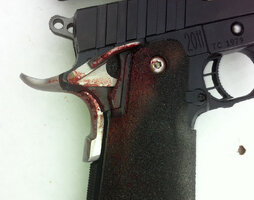Motivation:
After some recent threads, I decided to do a little testing to try to test some assertions that repeatedly come up whenever we discuss red dots versus iron sights. These are some of the assertions that typically get thrown out every time we have thread about red dots or lasers:
Lame Excuses:
I'm very out of practice. I did no shooting for six months last year and only started doing some shooting again during the summer of 2023. I did this test last Saturday, after not having shot at all for a couple months.
I'm over 60 and am in the early stages of cataracts, so my eye sight isn't great. I also have presbyopia, which makes it hard for me to focus on iron sights. Almost all of my shooting for the last 5 years has been with red dots.
The Guns:
I performed my test on a USPSA target at 10' and 25'. I wanted to also do 50', but didn't have time. For each distance, gun, and condition, I did 5 runs of two shots each. To reduce the variables, I started from low-ready, with the gun pointed at the base of the target stand (right at the ground level), with my finger on the trigger and my eyes looking at the A-zone of the target.
Ideally, this test would be performed with multiple shooters, switching up the order of the guns shot. But it was just me, and the test wasn't repeated or performed by multiple shooters. So this is a limited data set.
After some recent threads, I decided to do a little testing to try to test some assertions that repeatedly come up whenever we discuss red dots versus iron sights. These are some of the assertions that typically get thrown out every time we have thread about red dots or lasers:
- You'll never see the dot when up close.
- Red dots are slower up close because you will be looking for the dot.
- Lasers are the fastest sighting device.
- 45 ACP causes slower follow-up shots than 9mm.
- Full sized guns are easier to shoot than compact sized guns and thus will be faster.
Larger red dots are easier to use than smaller red dots.Red dots with larger windows are easier to use than red dots with smaller windows.- You do/don't need backup iron sights with red dots
Lame Excuses:
I'm very out of practice. I did no shooting for six months last year and only started doing some shooting again during the summer of 2023. I did this test last Saturday, after not having shot at all for a couple months.
I'm over 60 and am in the early stages of cataracts, so my eye sight isn't great. I also have presbyopia, which makes it hard for me to focus on iron sights. Almost all of my shooting for the last 5 years has been with red dots.
The Guns:
- Glock 19 Gen 5, RMR, all-black suppressor height iron sights, Glock minus connector. This is my usual carry gun.
- Glock 19 Gen 4, no red dot, tritium front sight, all black rear sight, Glock minus connector.
- Glock 34 Gen 5, SRO, standard Glock plastic sights (which are blocked by the red dot), Apex trigger. This is my usual competition gun.
- Kimber 1911, 5", Crimson Trace laser grips, tritium front sight with all-black rear sight. ~3.5 lb trigger. I haven't shot this gun in about 10 years and haven't changed the laser battery in about 15 years.
- 4" Smith & Wesson Model 19, Crimson Trace laser grips, gold bead front sight, all-black rear target sight blade, ~7 lb DA trigger. I haven't shot this gun in about 10 years and haven't changed the laser battery in about 15 years.
I performed my test on a USPSA target at 10' and 25'. I wanted to also do 50', but didn't have time. For each distance, gun, and condition, I did 5 runs of two shots each. To reduce the variables, I started from low-ready, with the gun pointed at the base of the target stand (right at the ground level), with my finger on the trigger and my eyes looking at the A-zone of the target.
Ideally, this test would be performed with multiple shooters, switching up the order of the guns shot. But it was just me, and the test wasn't repeated or performed by multiple shooters. So this is a limited data set.
Last edited:

![Puke [puke] [puke]](/xen/styles/default/xenforo/smilies.vb/023.gif) on my 34, those sights are not visible through the SRO. So with the SRO off, I was sighting just using the outline of the SRO over the target. My hit factor for the Glock 19 with the RMR off was 10.61, so I was better with that than the 34 with the SRO off. I attribute that to the fact that I can see the backup iron sights on the Glock 19 but not the Glock 34. So I think backup iron sights are important when you have a red dot on your pistol.
on my 34, those sights are not visible through the SRO. So with the SRO off, I was sighting just using the outline of the SRO over the target. My hit factor for the Glock 19 with the RMR off was 10.61, so I was better with that than the 34 with the SRO off. I attribute that to the fact that I can see the backup iron sights on the Glock 19 but not the Glock 34. So I think backup iron sights are important when you have a red dot on your pistol.